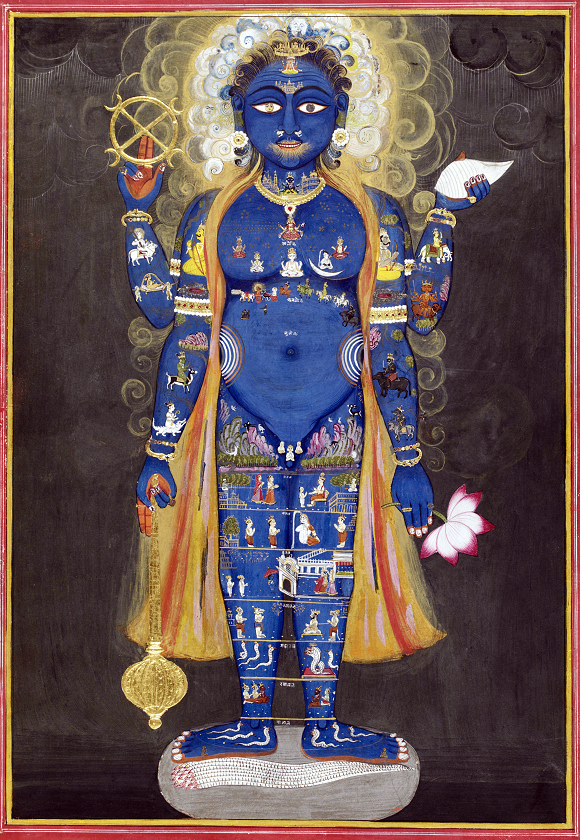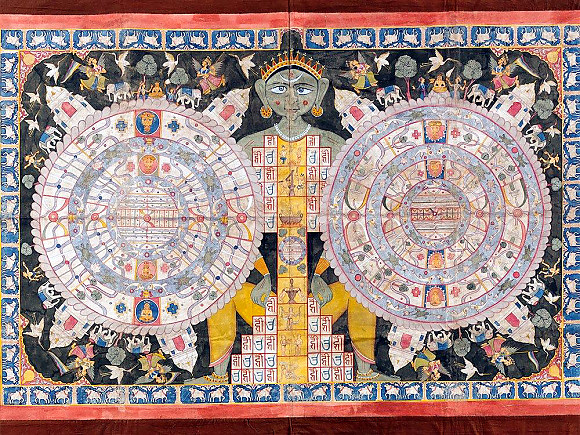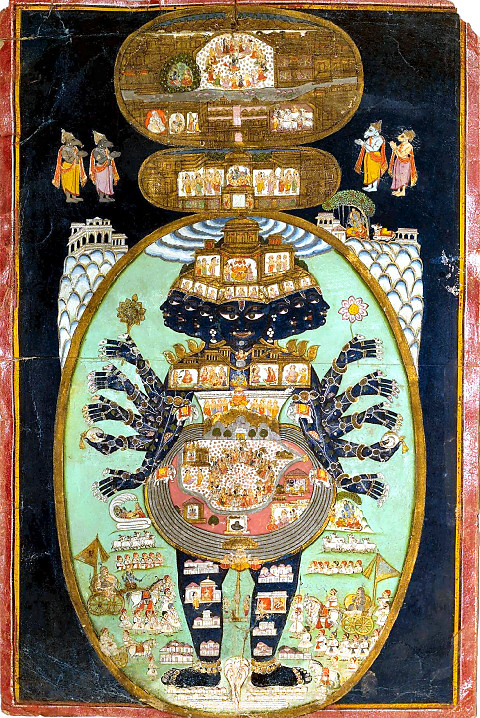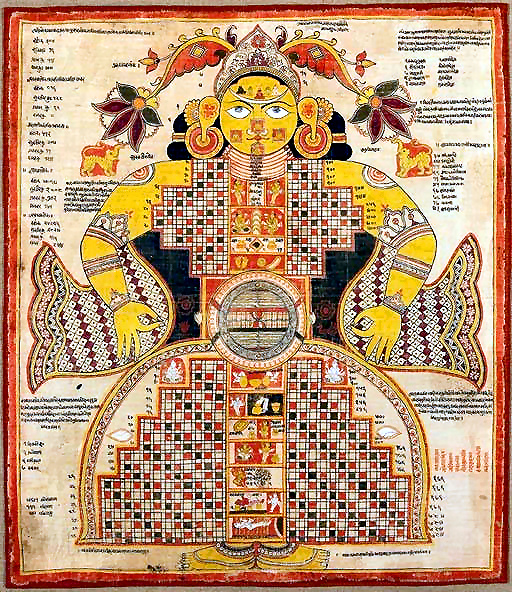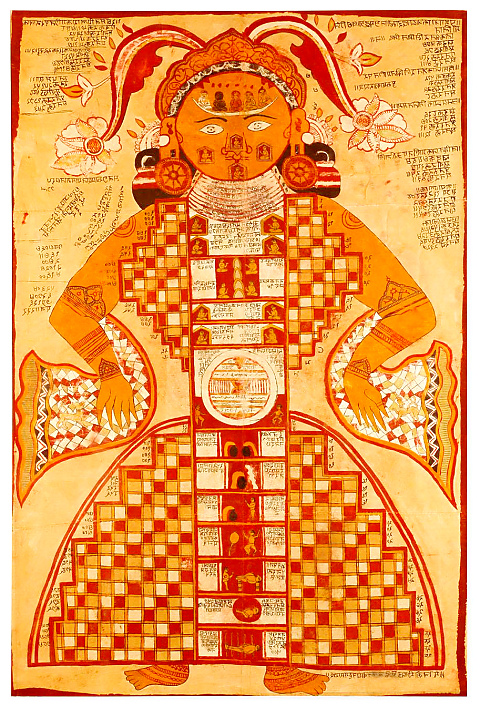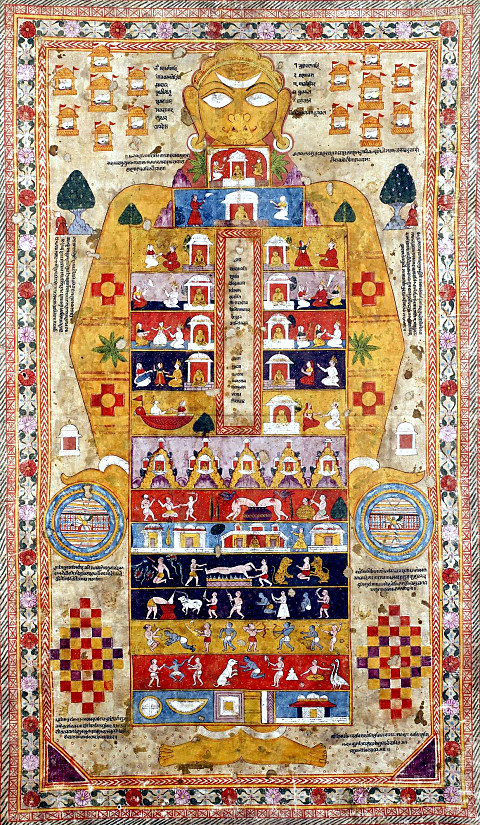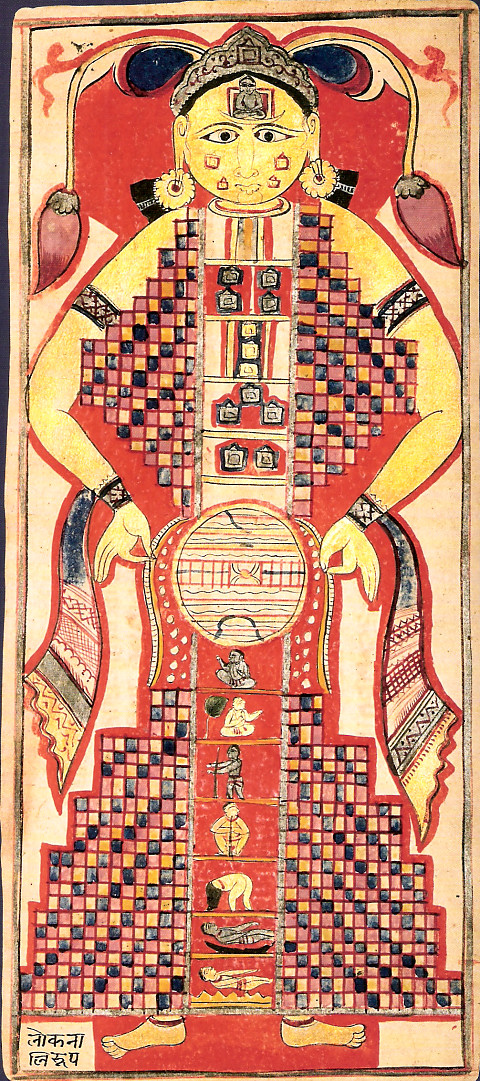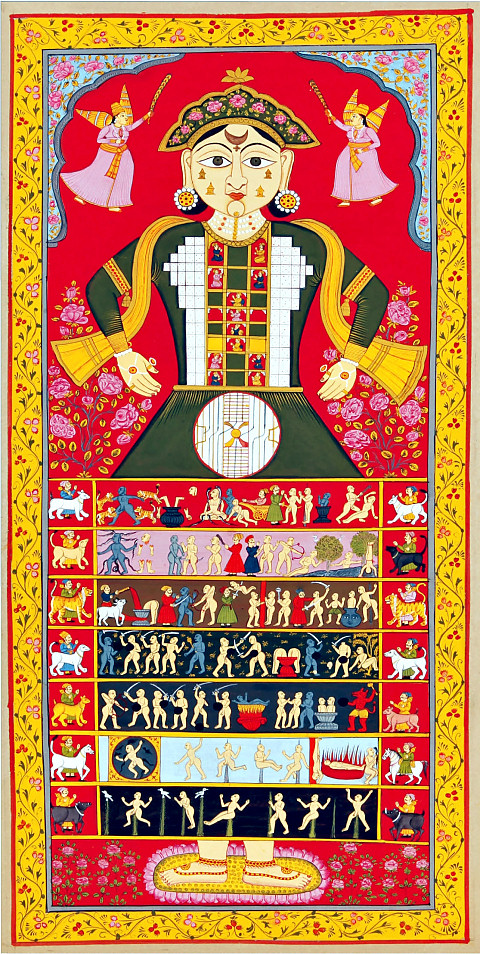
Virāṭ-rūpa or Viśva-rūpa - the Lords Cosmic Form
In the material world the Lord is designated as virāṭ, hiraṇyagarbha and kāraṇa.
But beyond these three designations, the Lord is ultimately in the fourth dimension.
Virāṭ-rūpa or Viśva-rūpa - the Lords Cosmic Form
Description from Śrīmad-Bhāgavatam
The description of the Virāṭ-rūpa (virāṭ-puruṣa), the cosmic form of the Lord, is given in the Śrīmad-Bhāgavatam, Canto 2, Chapter 1, Text 34-39.
The description of the gigantic form of the Personality of Godhead made in the Eleventh Chapter of the Bhagavad-gītā is further explained here in the Śrīmad-Bhāgavatam. The description in the Bhagavad-gītā (11.30) runs as follows: "O Viṣṇu, I see You devouring all people in Your blazing mouths and covering all the universe by Your immeasurable rays. Scorching the worlds, You are manifest." In that way, Śrīmad-Bhāgavatam is the postgraduate study for the student of the Bhagavad-gītā. Both of them are the science of Kṛṣṇa, the Absolute Truth, and so they are interdependent.
Persons who are unable to pin their faith on the personal feature of the Absolute are given a chance to associate with His virāṭ-rūpa, or the cosmic impersonal feature of the Lord. Those who want to see the Lord with their present material eyes or with the material senses are advised to meditate on the gigantic external feature called the virāṭ-rūpa. One should hear of the universal position of the virāṭ form of the Lord as described in Śrīmad-Bhāgavatam. That will help one save himself from material conditional life and gradually elevate him to the path of liberation so that he can go back home, back to Godhead.
One is advised herewith to meditate upon the virāṭ-rūpa specified in the previous chapters in order to understand how the different planets, seas, mountains, rivers, birds, beasts, human beings, demigods and all that we can conceive are but different parts and limbs of the Lord's virāṭ form. This sort of thinking is also a type of meditation on the Absolute Truth, and as soon as such meditation begins, one develops one's godly qualities, and the whole world appears to be a happy and peaceful residence for all the people of the world. Without such meditation on God, either personal or impersonal, all good qualities of the human being become covered with misconceptions regarding his constitutional position, and without such advanced knowledge, the whole world becomes a hell for the human being.
The conception of the virāṭ-puruṣa, or the gigantic form of the Supreme Lord, is said to include all the dominating demigods as well as the dominated living beings. Even the minutest part of a living being is controlled by the empowered agency of the Lord. Since the demigods are included in the gigantic form of the Lord, worship of the Lord, whether in His gigantic material conception or in His eternal transcendental form as Lord Śrī Kṛṣṇa, also appeases the demigods and all the other parts and parcels, as much as watering the root of a tree distributes energy to all of the tree's other parts. Consequently, for a materialist also, worship of the universal gigantic form of the Lord leads one to the right path. One need not risk being misled by approaching many demigods for fulfillment of different desires. The real entity is the Lord Himself, and all others are imaginary, for everything is included in Him only.
The process of meditation recommended in the Śrīmad-Bhāgavatam is not to fix one's attention on something impersonal or void. The meditation should concentrate on the person of the Supreme Godhead, either in His virāṭ-rūpa, the gigantic universal form, or in His sac-cid-ānanda-vigraha [Bs. 5.1], as described in the scriptures. There are authorized descriptions of Viṣṇu forms, and there are authorized representations of Deities in the temples. Thus one can practice meditating upon the Deity, concentrating his mind on the lotus feet of the Lord and gradually rising higher and higher, up to His smiling face. The more one concentrates on the transcendental form of the Lord, either on the lotus feet, the calves, the thighs or the chest, the more one becomes purified.
In the Bhagavad-gītā 11.19 Arjuna has seen the Visva-rupa or cosmic form of the Lord and confirms that the sun and moon are His eyes. Lord Krsna Himself states: “Of the Ādityas I am Viṣṇu, of lights I am the radiant sun, I am Marīci of the Maruts, and among the stars I am the moon.” (BG 10.22)
Arjuna saw in that universal form unlimited mouths and unlimited eyes. It was all wondrous. The form was decorated with divine, dazzling ornaments and arrayed in many garbs. He was garlanded gloriously, and there were many scents smeared over His body. All was magnificent, all-expanding, unlimited. This was seen by Arjuna.
The Loka-Puruṣa (cosmic man), according to the Jain cosmology, with all the worlds
Jain Mandala painting with depiction of the universe as double cosmic diagram and in the shape of a person. Each diagram centered by Mount Meru surrounded by the concentric circles of the continents and the Sea of salt filled with sea animals and lotus flowers. The edges embellished with symbols of the worldly spheres like temples, figures, elephants, birds and trees, at the outer rim a blue border with a frieze of goats. The cosmological Jain Mandala shows Adhaidvipa, known as the two and a half continents where mortals dwell. In the Jain cosmography the universe is divided into three kingdoms: The upper with the celestials, the center with the mortals and the lower with the damned. The continents are arranged concentrically and separated by two annular oceans. The central continent is called Jambudvipa, the internal ocean is known as Lavaṇa-samudra (ocean of salt) and in the center there is Mount Meru. In each of the four outer corners a Jina or Tirthankara, one of the 24 Jain saviours, is seated in meditating position.
This gigantic manifestation of the phenomenal material world as a whole is the personal body of the Absolute Truth, wherein the universal resultant past, present and future of material time is experienced. (SB 2.1.24)
The gigantic universal form of the Personality of Godhead, within the body of the universal shell, which is covered by sevenfold material elements, is the subject for the virāṭ conception. (SB 2.1.25)
Persons who have realized it have studied that the planets known as Pātālaconstitute the bottoms of the feet of the universal Lord, and the heels and the toes are the Rasātala planets. The ankles are the Mahātala planets, and His shanks constitute the Talātala planets. (SB 2.1.26)
The universe is divided into fourteen planetary systems. Seven planetary systems, called Bhūr, Bhuvar, Svar, Mahar, Janas, Tapas and Satya, are upward planetary systems, one above the other. There are also seven planetary systems downward, known as Atala, Vitala, Sutala, Talātala, Mahātala, Rasātala and Pātāla, gradually, one below the other. In this verse, the description begins from the bottom because it is in the line of devotion that the Lord's bodily description should begin from His feet. Śukadeva Gosvāmī is a recognized devotee of the Lord, and he is exactly correct in the description.
The knees of the universal form are the planetary system of the name Sutala, and the two thighs are the Vitala and Atala planetary systems. The hips are Mahītala, and outer space is the depression of His navel. (SB 2.1.27)
The chest of the Original Personality of the gigantic form is the luminary planetary system, His neck is the Mahar planets, His mouth is the Janas planets, and His forehead is the Tapas planetary system. The topmost planetary system, known as Satyaloka, is the head of He who has one thousand heads. (SB 2.1.28)
The effulgent luminary planets like the sun and the moon are situated almost in the midplace of the universe, and as such they are to be known as the chest of the original gigantic form of the Lord. And above the luminary planets, called also the heavenly places of the universal directorate demigods, are the Mahar, Janas and Tapas planetary systems, and, above all, the Satyaloka planetary system, where the chief directors of the modes of material nature reside, namely Viṣṇu, Brahmā and Śiva. This Viṣṇu is known as the Kṣīrodakaśāyī Viṣṇu, and He acts as the Supersoul in every living being. There are innumerable universes floating on the Causal Ocean, and in each of them the representation of the virāṭ form of the Lord is there along with innumerable suns, moons, heavenly demigods, Brahmās, Viṣṇus and Śivas, all of them situated in one part of the inconceivable potency of Lord Kṛṣṇa, as stated in the Bhagavad-gītā (10.42).
An Illustration of Lord Krishna in his Cosmic Form - Krishna is depicted here in his cosmic form as Vishnu, centering the Universe with his serpent Sheshnaga beneath. The Pandava and Kaurava armies gather on each side of his feet. The seven oceans of the earth encircle his body and at their center is Krishna dancing in his rasalila or cosmic cycle of ecstacy. Brahma sits within the crown on his head while Shiva pays obeisance from his abode in Mount Kailasa on the upper right. Above, Krishna is seen dancing the divine rasalila in his heavenly abode as the four Vedas, the fountain of all knowledge stand respectfuly on either side. Opaque watercolor heightened with gold on paper.
His arms are the demigods headed by Indra, the ten directional sides are His ears, and physical sound is His sense of hearing. His nostrils are the two Aśvinī-kumāras, and material fragrance is His sense of smell. His mouth is the blazing fire. (SB 2.1.29)
The sphere of outer space constitutes His eyepits, and the eyeball is the sun as the power of seeing. His eyelids are both the day and night, and in the movements of His eyebrows, the Brahmā and similar supreme personalities reside. His palate is the director of water, Varuṇa, and the juice or essence of everything is His tongue. (SB 2.1.30)
They say that the Vedic hymns are the cerebral passage of the Lord, and His jaws of teeth are Yama, god of death, who punishes the sinners. The art of affection is His set of teeth, and the most alluring illusory material energy is His smile. This great ocean of material creation is but the casting of His glance over us. (SB 2.1.31)
Modesty is the upper portion of His lips, hankering is His chin, religion is the breast of the Lord, and irreligion is His back. Brahmājī, who generates all living beings in the material world, is His genitals, and the Mitrā-varuṇas are His two testicles. The ocean is His waist, and the hills and mountains are the stacks of His bones. (SB 2.1.32)
O King, the rivers are the veins of the gigantic body, the trees are the hairs of His body, and the omnipotent air is His breath. The passing ages are His movements, and His activities are the reactions of the three modes of material nature. (SB 2.1.33)
O best amongst the Kurus, the clouds which carry water are the hairs on His head, the terminations of days or nights are His dress, and the supreme cause of material creation is His intelligence. His mind is the moon, the reservoir of all changes. (SB 2.1.34)
The principle of matter [mahat-tattva] is the consciousness of the omnipresent Lord, as asserted by the experts, and Rudradeva is His ego. The horse, mule, camel and elephant are His nails, and wild animals and all quadrupeds are situated in the belt zone of the Lord. (SB 2.1.35)
Varieties of birds are indications of His masterful artistic sense. Manu, the father of mankind, is the emblem of His standard intelligence, and humanity is His residence. The celestial species of human beings, like the Gandharvas, Vidyādharas, Cāraṇas and angels, all represent His musical rhythm, and the demoniac soldiers are representations of His wonderful prowess. (SB 2.1.36)
The virāṭ-puruṣa's face is the brāhmaṇas, His arms are the kṣatriyas, His thighs are the vaiśyas, and the śūdras are under the protection of His feet. All the worshipable demigods are also overtaken by Him, and it is the duty of everyone to perform sacrifices with feasible goods to appease the Lord. (SB 2.1.37)
I have thus explained to you the gross material gigantic conception of the Personality of Godhead. One who seriously desires liberation concentrates his mind on this form of the Lord, because there is nothing more than this in the material world. (SB 2.1.38)
One should concentrate his mind upon the Supreme Personality of Godhead, who alone distributes Himself in so many manifestations just as ordinary persons create thousands of manifestations in dreams. One must concentrate the mind on Him, the only all-blissful Absolute Truth. Otherwise one will be misled and will cause his own degradation. (SB 2.1.39)
Shape of Universe as per Jain cosmology in form of a cosmic man, the Loka-Puruṣa
From Samghayanarayana loose-leaf manuscript India;
ca. 16th century Ink, opaque watercolor, and gold on paper.
